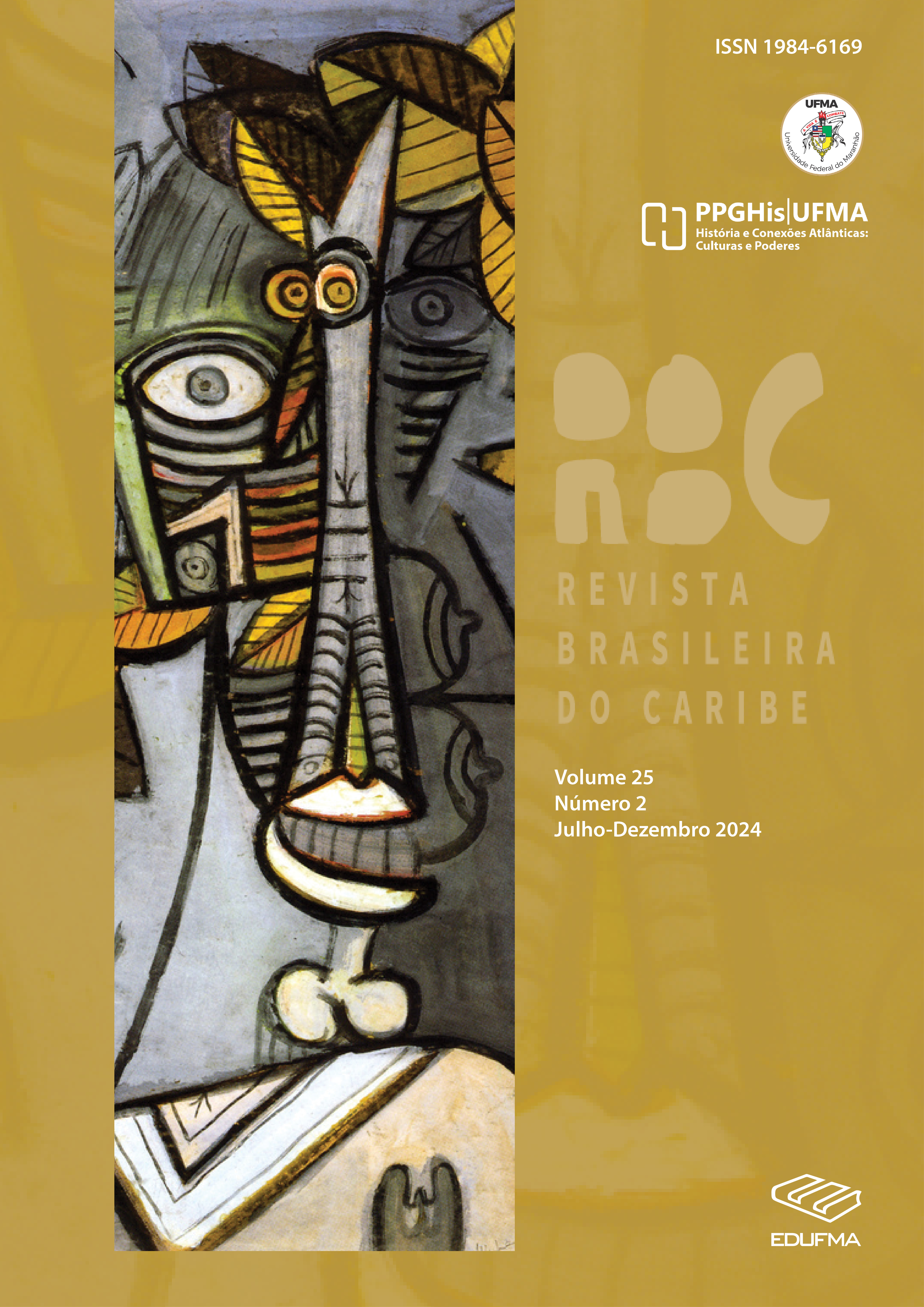Relaciones interculturales y transculturación en Monkey Hunting, de Cristina García
DOI:
https://doi.org/10.18764/1984-6169v25n2e24323Palabras clave:
Monkey Hunting, Cristina García, transculturación, relaciones interculturalesResumen
Siguiendo el enfoque crítico de las relaciones interculturales propuesto por Rona Halualani como marco analítico, este artículo estudia la transculturación cubana en la novela Monkey Hunting (2003), de la escritora cubano-americana Cristina García, teniendo en cuenta que la coexistencia e interacción de las culturas son multidireccionales y están afectadas por las relaciones de poder, particularmente la raza y la clase social, para elucidar sobre los intercambios culturales, la adaptación, el cambio y la evolución cultural y la dinámica social e intercultural en Cuba desde la segunda mitad del siglo XIX hasta gran parte del siglo XX reflejada en la historia de cuatro generaciones de una familia multicultural chino-afrocubana formada por un ex culí chino y una ex esclava cubana, mostrando así la dinámica y la complejidad del proceso de transculturación específico del Caribe español como piedra angular de la cultura cubana.
Descargas
Citas
ALFONSO-FORERO, Ann. ‘A Whole New Race’: Chinese Cubans and Hybrid Identities in Cristina García’s Monkey Hunting. Miami, Anthurium: A Caribbean Studies Journal, vol. 7, no. 1, 2010, p. 1-9. https://anthurium.miami.edu/articles/10.33596/anth.137/galley/133/download.
ALLOLIO-NÄCKE, Lars. Transculturalism. In THOMAS TEO (coord.) Encyclopedia of Critical Psychology. Springer New York, 2014, p. 1985-1987, https://doi.org/10.1007/978-1-4614-5583-7.
BALLOU, Maturin M. History of Cuba or, Notes of a Traveller in the Tropics. Londres: Sampson & Co., 1854. Disponible en: https://www.gutenberg.org/cache/epub/32812/pg32812-images.html. Acceso el 11 de agosto de 2024.
BARCIA, María del Carmen. Sociedad imaginada: la Isla de Cuba en el siglo XIX. Murcia, CONTRASTES. Revista de Historia, no. 12, enero 2003, p. 21–42. Disponible en: https://digitum.um.es/digitum/bitstream/10201/12734/1/832561.pdf. Acceso en julio, 2024.
BENÍTEZ-ROJO, Antonio. La isla que se repite: El Caribe y la perspectiva posmoderna. Editorial Casiopea, 1998.
CABRERA, Lydia. El Monte. La Habana: Editorial Letras Cubanas, 1993.Disponible en: https://www.academia.edu/7856434/El_Monte_Lidia_Cabrera.
DE LA FUENTE, Alejandro, y REID, George. Estudios afrolatinoamericanos: una introducción. Buenos Aires: CLACSO, 2018. Disponible en www.biblioteca.clacso.edu.ar. Acceso el 20 de agosto de 2024.
ENG, Yrmina. De China y los chinos en el Imaginario Cubano. In JOAQUÍN BELTRÁN et al. (coord.) Apuntes sobre Las Percepciones de Antes, de Ahora y de Siempre. Representaciones de China en Las Américas y la Península Ibérica. Bellaterra Edicions, 2016, p. 127–48. Disponible en: www.researchgate.net/publication/331485774_Representaciones_de_China_en_las_Americas_y_la_Peninsula_Iberica. Acceso el 4 de julio de 2023.
EPSTEIN, Mikhail. Transculture: A Broad Way between Globalism and Multiculturalism. Hoboken, The American Journal of Economics and Sociology, vol. 68, no. 1, 2009, p. 327–52. Disponible en http://www.jstor.org/stable/27739771. Acceso el 27 de enero de 2024.
FERNANDEZ, Nadine T. Revolutionizing Romance: Interracial Couples in Contemporary Cuba. New Brunswick: Rutgers University Press, 2010. Disponible en: ProQuest Ebook Central, https://www.proquest.com/legacydocview/EBC/868533?accountid=13814. Acceso el 3 de agosto de 2024.
FERNÁNDEZ OLMOS, Marguerite, y PARAVISINI-GEBERT, Lizabeth. Creole Religions of the Caribbean: An Introduction from Vodou and Santería to Obeah and Espiritismo.Nueva York: New York University Press, 2011.
FOTOSDLAHABANA. Búscate un chino que te ponga un cuarto (Viejos refranes habaneros). fotosdlahabana, Curiosidades, 26 de mayo, 2021. Disponible en: https://fotosdlahabana.com/buscate-chino-que-ponga-cuarto-refran-cuba/. Acceso el 10 de agosto de 2024.
FRAGINALS, Manuel. La plantación, crisol de la sociedad antillana. París, El Correo de la UNESCO, diciembre 1981, p. 10-14. Disponible en: https://unesdoc.unesco.org/ark:/48223/pf0000074754_spa. Acceso en agosto, 2024.
GARCÍA, Cristina. Monkey Hunting. Nueva York: The Random House Publishing Group, 2003.
GUANCHE, Jesús. Componentes étnicos de la nación cubana. Shijiazhuang: Universidad de Estudios Internacionales de Hebei, 2020. https://www.academia.edu/42171548/Componentes_étnicos_de_la_nación_cubana_Cuarta_edición_revisada_y_actualizada_.
GUEST, Kenneth J. Essentials of Cultural Anthropology: A Toolkit for a Global Age. Nueva York: W. W. Norton & Company, 2018.
GUERRA, Zuleica Romay. From Afro-Cubans to black Cubans. Africanity and skin color in the Cuban social imaginary. Porto Alegre, Brazilian Journal of African Studies, vol. 3, no. 6, 2018, p. 75-88. Disponible en https://www.seer.ufrgs.br/rbea/article/download/84192/52369. Acceso el 4 de julio de 2024.
HALUALANI, Rona T. Intercultural Communication: A Critical Perspective. San Diego: Cognella Academic Publishing, 2021.
HELLY, Denise. Les Chinois Macao à Cuba: 1847-1886. Chicoutimi: Université du Québec à Chicoutimi, 2008 (1979). Disponible en: http://classiques.uqac.ca. Acceso el 5 de agosto de 2024.
LEI, Chunyi. Las influencias y huellas de la cultura china en Cuba: 1847–1959. Letras, v. 92, n. 135, 2021.
LYSIK, Marta. Multiple Trajectories of Slavery: Cristina Garcia’s Monkey Hunting as a Transnational Neo-Slave Narrative. In JUDITH MISRAHI-BARAK (coord.) Revisiting Slave Narratives. Université Paul-Valéry, 2007, p. 275-96.
MARTINEZ-ALIER, Verena. Marriage, Class and Colour in Nineteenth Century Cuba: A Study of Racial Attitudes and Sexual Values in a Slave Society. Cambridge: Cambridge University Press, 1974. Disponible en: https://www.cambridge.org/core/books/marriage-class-and-colour-in-nineteenth-century-cuba/E0D9861770E7B59FCBB28FDBD16D7CF4.
MARTÍNEZ, Manuel. Chinese-Cuban Identity in Cristina García’s Monkey Hunting and Daína Chaviano’s La isla de los amores infinitos. Miami, Caribe; Revista de Cultura y Literatura, vol. 10, enero 2007-2008, p. 95-112. Disponible en: ProQuest, https://www.proquest.com/other-sources/chinese-cuban-identity-cristina-garcías-i-monkey/docview/2639341976/se-2.
MARTINEZ, Yolanda P. The Search for Home, Identity, and National Belonging in U.S./Cuban Cristina García’s Monkey Hunting. Nueva York, Wadabagei, vol. 9, no. 1, 2006, p.81-97. https://conservancy.umn.edu/bitstream/handle/11299/166169/Garc%C3%ADa,%20Cristina.pdf;sequence=1. Accessso el 5 de agosto de 2024.
MÉNDEZ, Susan C. ‘Like a Dialect Freaked by Thunder:’ Spiritual Articulations of Survival and Identity in Cristina García’s ‘Dreaming in Cuban’ and ‘Monkey Hunting.’” Chicana/Latina Studies, vol. 11, no. 1, 2011, p. 124–57. JSTOR, http://www.jstor.org/stable/23345302. Acceso el 3 de septiembre de 2024.
NAKAYAMA, Thomas, y HALUALANI, Rona. The Handbook of Critical Intercultural Communication. Hoboken: Wiley-Blackwell, 2010. https://onlinelibrary.wiley.com/doi/book/10.1002/9781444390681.
NARANJO OROVIO, Consuelo. La Inmigración China en Cuba, Siglos XIX y XX: Debates Económicos y Discursos Identitarios. In ADRIANA MUKIEN (org.) La Presencia China en El Gran Caribe: Ayer y Hoy. Centro de Estudios Caribeños (PUCMM), 2022, p. 171-244. https://digital.csic.es/handle/10261/263728.
NG, Rudolph. Chinese “Coolies”: Hidden Drivers of Nineteenth-Century Cuba’s Economic Transformation. Itinerario, p. 1–25, 2025. doi:10.1017/S0165115325100089.
ORTIZ, Fernando. Contrapunteo cubano del tabaco y del azúcar. La Habana: Editorial de Ciencias Sociales, 1983.
PARZIALE, Amy. Counter-Archives of Trauma in Cristina García’s Monkey Hunting. Revista de Estudios Hispánicos, vol. 52, no. 3, 2018, p. 937-958. https://dx.doi.org/10.1353/rvs.2018.0070.
PRATT, Mary Louise. Imperial Eyes: Travel Writing and Transculturation. Oxfordshire: Routledge, 2007. https://www.taylorfrancis.com/books/mono/10.4324/9780203932933/imperial-eyes-mary-louise-pratt. Acceso el 2 de agosto de 2024.
SCHULTERMANDL, Silvia. ‘What Did Any of It Have to Do with Race?’: Raced Chronotopes in Cristina García’s Monkey Hunting. Atlantic Studies, vol. 8, no. 1, marzo 2011, p. 93–107. https://doi.org/10.1080/14788810.2011.539791. Acceso el 9 de agosto de 2024.
SHI, Guang. Los diplomáticos chinos en Cuba, 1847–1874. In: CALVO GONZÁLEZ, Patricia; CORTINA ORERO, Eudald; GONZÁLEZ LAGE, Valeria (coords.). Los caminos de América, 2022. p. 303–308. ISBN 978-84-19155-73-3.
TAYLOR, Diana. Transculturating Transculturation. Nueva York: Performing Arts Journal, vol. 13, no. 2, mayo 1991, p. 90. https://doi.org/10.2307/3245476.
YUN, Lisa. The Coolie Speaks: Chinese Indentures Laborers and African Slaves of Cuba. Philadelphia: Temple University Press, 2008. Disponible en https://www.jstor.org/stable/j.ctt14bs7bs. Acceso el 14 de agosto de 2024.
ZAPATA-CALLE, Ana. El mundo de Chen Pan en “Monkey Hunting” de Cristina García: Chinos, africanos y criollos en la diáspora cubana. Tempe, Chasqui, vol. 41, no. 1, 2012, pp. 170–86. Disponible en http://www.jstor.org/stable/43589689. Acceso el 5 de julio 2024.
Descargas
Publicado
Cómo citar
Número
Sección
Licencia
Derechos de autor 2025 Adolfo Licoa

Esta obra está bajo una licencia internacional Creative Commons Atribución 4.0.
A Revista Brasileira do Caribe está licenciada com a Licença Creative Commons Atribuição 4.0 Internacional.










